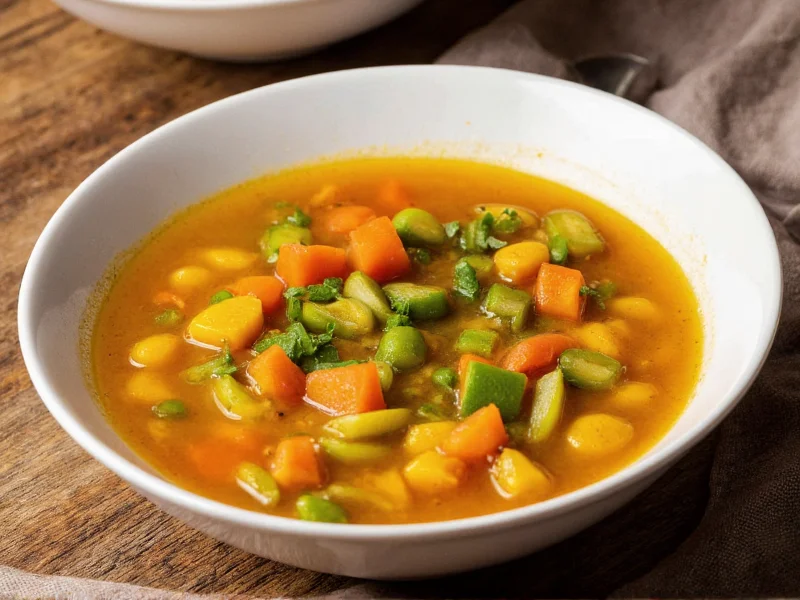Understanding Vegetable Soup Mix Components
Commercial vegetable soup mixes generally contain a combination of dehydrated vegetables, flavor enhancers, and thickeners. The most common vegetables found in these blends include:
| Common Ingredients | Purpose in Mix | Typical Form |
|---|---|---|
| Carrots | Sweetness, color | Dehydrated slices or powder |
| Celery | Flavor base, aroma | Dehydrated flakes |
| Onions | Flavor foundation | Dehydrated granules |
| Peas | Protein, texture | Dehydrated or freeze-dried |
| Corn | Sweetness, texture | Dehydrated kernels |
Many store-bought vegetable soup mix options include additional ingredients like potato flakes for thickening, salt for preservation and flavor, and various seasonings such as parsley, thyme, and garlic powder. Some premium mixes may contain small amounts of tomato powder or vegetable broth concentrate to enhance flavor depth.
Nutritional Considerations of Vegetable Soup Mixes
When evaluating the nutritional profile of vegetable soup mix products, several factors deserve attention. Most commercial blends contain between 700-1,200mg of sodium per serving, which represents 30-50% of the recommended daily intake. This high sodium content serves as both a flavor enhancer and preservative but can be problematic for individuals monitoring their salt intake.
On the positive side, quality vegetable soup mix varieties provide essential vitamins and minerals from the dehydrated vegetables. Look for mixes containing at least 3 grams of dietary fiber per serving, which indicates a substantial vegetable content rather than primarily starches and fillers. When comparing different vegetable soup mix brands, check for artificial preservatives like BHA or BHT, which some health-conscious consumers prefer to avoid.
Creative Applications Beyond Basic Soup Preparation
Understanding how to use vegetable soup mix in recipes extends far beyond simply following package instructions. Culinary enthusiasts can transform these convenient blends into versatile kitchen staples. For instance, reconstituted vegetable soup mix makes an excellent sauce base for casseroles, adding both flavor and moisture without additional liquid.
Professional chefs often incorporate vegetable soup mix into unexpected applications such as:
- As a seasoning blend for roasted vegetables
- Mixed with breadcrumbs for vegetable patties
- Added to bread dough for vegetable-flavored rolls
- Stirred into mashed potatoes for added nutrition
- Used as a flavor base for grain pilafs
When exploring creative vegetable soup mix recipes, consider adding fresh herbs during the final minutes of cooking to brighten flavors that may have diminished during the dehydration process. Acidic elements like lemon juice or vinegar can also help balance the sometimes-flat flavor profile of reconstituted dehydrated vegetables.
Homemade Vegetable Soup Mix: A Healthier Alternative
Creating your own vegetable soup mix at home offers significant advantages over store-bought options, particularly regarding ingredient control and sodium content. The basic process involves dehydrating fresh vegetables and blending them with preferred seasonings.
To make a simple homemade vegetable soup mix recipe, follow these steps:
- Dehydrate chopped carrots, celery, onions, and bell peppers at 125°F (52°C) for 8-12 hours
- Grind dried vegetables to a coarse powder in a food processor
- Mix with dried herbs (2 tbsp parsley, 1 tbsp thyme, 1 tsp rosemary)
- Add optional nutritional yeast for umami flavor (¼ cup)
- Store in an airtight container away from light and moisture
This homemade approach to vegetable soup mix preparation eliminates unnecessary additives while preserving more nutrients than commercial versions. The resulting mix typically contains only one-third the sodium of store-bought alternatives while offering fresher, more vibrant flavors. For those interested in long-term storage solutions, vacuum-sealing portions of homemade vegetable soup mix can extend shelf life to 18-24 months when stored in a cool, dark place.
Storage Guidelines and Shelf Life Expectations
Proper storage significantly impacts the quality and safety of both commercial and homemade vegetable soup mix products. Unopened commercial mixes generally maintain optimal quality for 12-18 months when stored in a cool, dry pantry. Once opened, transfer contents to an airtight container to prevent moisture absorption, which can cause clumping and spoilage.
Homemade vegetable soup mix requires more careful storage due to the absence of commercial preservatives. For best results, store in glass jars with oxygen absorbers, which can extend shelf life to 12-18 months. Always check for signs of spoilage before use, including:
- Unusual odors (rancid, musty, or sour smells)
- Visible mold or insect activity
- Significant color changes from original state
- Clumping that doesn't break apart easily
When properly stored, vegetable soup mix maintains its flavor profile and nutritional value for extended periods. However, for optimal taste and nutrient retention, use within 6 months of opening for the best culinary experience.
Enhancing Flavor Profiles in Vegetable Soup Mix Dishes
Even the highest quality vegetable soup mix benefits from thoughtful enhancements that elevate the final dish. Professional chefs employ several techniques to maximize flavor when working with these convenient blends. Adding aromatics like fresh garlic and ginger during the initial cooking phase creates a flavor foundation that complements rather than competes with the mix's existing profile.
For those seeking to improve store-bought vegetable soup mix recipes, consider these professional tips:
- "Bloom" dried spices in olive oil before adding liquid to intensify flavors
- Add a Parmesan rind while simmering for umami depth
- Finish with a splash of acid (lemon juice or apple cider vinegar) to brighten flavors
- Stir in a tablespoon of miso paste for complex savory notes
- Add fresh herbs during the last 5 minutes of cooking
Understanding vegetable soup mix limitations helps determine appropriate enhancements. Most commercial blends lack sufficient umami compounds, making additions like tomato paste, soy sauce, or dried mushrooms particularly effective for creating more restaurant-quality results from convenient packaged mixes.











 浙公网安备
33010002000092号
浙公网安备
33010002000092号 浙B2-20120091-4
浙B2-20120091-4